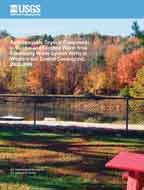Scientific Investigations Report 2007–5171

Scientific Investigations Report 2007–5171
By Thomas J. Trombley, Craig J. Brown, and Gregory C. Delzer
The body of the report is available in PDF Format (2,056 KB)
The cover of the report is also available in PDF Format (2,588 KB)
If you have Adobe® Acrobat® or Adobe® Acrobat® Reader® installed on your computer, you may view and print the PDF version of this report. Acrobat Reader, is a free download from Adobe Systems, Inc. Users with disabilities can view information concerning accessibility at access.Adobe.com.
A water-quality assessment by the U.S. Geological Survey (USGS) determined the occurrence of anthropogenic (manmade) organic compounds (AOCs) in water from 15 community water system (CWS) wells and associated finished drinking water. The study, which focused on water from the unconfined glacial stratified aquifer in western and central Connecticut, was conducted as part of the USGS National Water-Quality Assessment Program (NAWQA) Source Water-Quality Assessment (SWQA) project and included analysis of water samples for 88 volatile organic compounds (VOCs), 120 pesticides, and 50 other anthropogenic organic compounds (OAOCs).
During Phase I of the study, 25 AOCs were detected (12 VOCs, 10 pesticides, and 3 OAOCs) in source-water samples collected from 15 CWS wells sampled once from October 2002 to May 2003. Although concentrations generally were low (less than 1 microgram per liter), four compounds were detected at higher concentrations in ground water from four wells. The most frequently occurring AOCs were detected in more than half of the samples and included chloroform (87 percent), methyl tert-butyl ether (MTBE, 80 percent), 1,1,1-trichloroethane (67 percent), atrazine (60 percent), deethylatrazine (60 percent), perchloroethene (PCE, 53 percent), and simazine (53 percent). Trichloroethene (TCE) was detected in 47 percent of samples. Samples generally contained a mixture of compounds ranging from 2 to 19 detected compounds, with an average of 8 detected compounds per sample.
During Phase II of the study, 42 AOCs were detected in source-water samples collected from 10 resampled CWS wells or their associated finished water. Trihalomethanes accounted for most of the VOCs detections with all concentrations less than 1 microgram per liter. Chloroform, the most frequently detected VOC, was found in all source-water and all finished-water samples. As with the Phase I samples, other frequently detected VOCs included MTBE, and the solvents 1,1,1-trichloroethane, PCE, and TCE. Triazine herbicides and their degradation products accounted for most of the detected pesticides.
Abstract
Introduction
Purpose and Scope
Ground-Water Withdrawals and Land Use in the Study Area
Site Selection, Methods, and Human-Health Benchmarks
Site Selection and Methods
Human-Health Benchmarks
Consumer Confidence Reports and Source Water-Quality Assessments
Anthropogenic Organic Compounds in Source Water
Volatile Organic Compounds
Pesticides
Other Anthropogenic Organic Compounds
Anthropogenic Organic Compounds in Source and Associated Finished Water
Volatile Organic Compounds
Pesticides
Other Anthropogenic Organic Compounds
Summary
Acknowledgments
References Cited
Glossary
Appendix 1. Concentration and Benchmark Quotient Values for Detected Anthropogenic Organic Compounds in Samples of Source Water and Associated Finished Water, Connecticut SWQA Study
1–3. Maps showing—
1. Location of National Water-Quality Assessment (NAWQA) study units and Ground-Water Source Water-Quality Assessment (SWQA) study areas
2. Glacial stratified aquifer in western and central Connecticut and location of community water system wells sampled in Phase I (source water) and Phase II (source and finished water) of the Connecticut source water- quality assessmen
3. Land use in western and central Connecticut and location of community water system wells sampled in Phase I (source water) and Phase II (source and finished water) of the Connecticut source water-quality assessment
4–7. Graphs showing—
4. Concentration, number of detections, and benchmark quotient values for (A) volatile organic compounds, (B) pesticides, and (C) other anthropogenic organic compounds detected in 15 community water system wells sampled in Phase I (source water) of the Connecticut source water-quality assessmen
5. Concentrations and number of detections and (B) benchmark quotient values for volatile organic compounds detected in 10 community water system wells sampled in Phase II (source and finished water) of the Connecticut source water-quality assessment
6. Concentrations and number of detections and (B) benchmark quotient values for pesticides detected in 10 community water system wells sampled in Phase II (source and finished water) of the Connecticut source water-quality assessment
7. Concentrations and number of detections and (B) benchmark quotient values for other anthropogenic organic compounds detected in 10 community water system wells sampled in Phase II (source and finished water) of the Connecticut source water-quality assessment
1. Detection frequency, maximum concentration, and maximum benchmark quotient value for anthropogenic organic compounds detected in 15 community water system wells sampled in Phase I (source water) of the Connecticut source water- quality assessment
2. Detection frequency, maximum concentration, and maximum benchmark quotient value for anthropogenic organic compounds detected in 10 community water system wells sampled in Phase II (source and finished water) of the Connecticut source water-quality assessment
Trombley, T.J., Brown, C.J., and Delzer, G.C., 2007, Anthropogenic organic compounds in source and finished water from community water system wells in western and central Connecticut, 2002–2004: U.S. Geological Survey Scientific Investigations Report 2007–5171, 38 p.
For further information, contact:
Virginia de Lima, Director
Connecticut Water Science Center
101 Pitkin St.
East Hartford, CT 06108
Voice: 860-291-6740
Fax: 860-291-6799
Email: vdelima@usgs.gov
Visit our web site: http://ct.water.usgs.gov